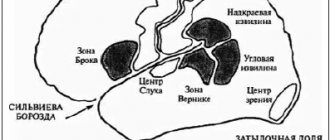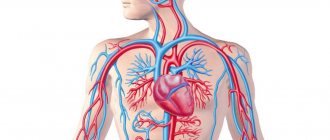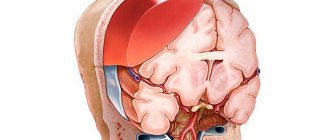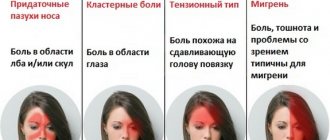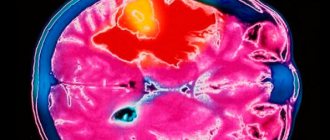Stupidity of consciousness is a pathological state of the psyche, characterized by a significant increase in the threshold of sensitivity to all stimuli emanating from the external world, with a simultaneous impoverishment of higher nervous activity. This phenomenon is also described in the scientific literature under the name “stunned consciousness syndrome.”
Some of the main indicators of the state of stupor are depression of consciousness, drowsiness, slowing down of thought processes, and inability to quickly form associations. At the same time, the patient partially retained the ability to communicate verbally.
In some cases, the state of stupor is a precursor to severe forms of depression of consciousness - stupor and often threatens to transition into an unconscious state - coma , from which the patient is almost always impossible to recover even with intense stimulation. However, most often the stun syndrome is a reversible phenomenon: a return to clear consciousness occurs as the causes of the anomaly are eliminated and the symptoms of the underlying disease fade.
Stupefaction: degrees of depression of consciousness and symptoms
Traditionally, stunned consciousness is usually divided into separate categories depending on the degree of mental depression into disorders: moderate and severe.
Moderate stunned
The main manifestations of moderate severity of stunning syndrome are a noticeable slowdown in all thought processes, significant difficulty in using cognitive resources, and a significant impoverishment of mental potential . With this disorder, the patient experiences a decrease in the possibility of active attention: he is not capable of purposeful, voluntary and controlled concentration of thoughts, vision, hearing on any processes, phenomena, objects.
With moderate deafness, it is possible to establish verbal contact with the individual. However, a person does not answer the question posed immediately, but some time after he hears the question. Often, in order for a subject to respond to an opponent’s statement, it is necessary to repeat the same remark several times. For some people who are in a state of deafness, additional methods of stimulation are required, for example: calling the patient by name, touching his body, or lightly patting his face.
With stunning syndrome, a person adequately perceives and correctly carries out assigned tasks, but he carries out all commands at a slow pace. When exposed to pain receptors, the subject experiences targeted motor, humoral and behavioral reactions.
Externally, the patient looks lethargic, apathetic and exhausted. Those around us notice a significant depletion of facial expressions and gestures. The patient's speech is slow, the patient pronounces phrases in a quiet voice.
A distinctive feature of a moderate degree of deafness is the person’s complete preservation of orientation in his own personality. There are no distortions, exaggerations, or fantasies in the patient’s stories about his own personality. At the same time, the individual has difficulty navigating time: he cannot correctly name the current date and day of the week. He also incorrectly determines his location: a person is not able to accurately indicate in which specific place he is now.
Deep stunned
The leading symptom of a deep degree of deafness is a significant narrowing of mental capabilities, deterioration of almost all intellectual abilities . The patient is almost constantly in a drowsy state, which is occasionally replaced by episodes of excessive motor activity. At such moments, it seems that the person was abruptly awakened, and, being in a state of half-asleep, he makes random, illogical and useless movements.
With a deep degree of stunned consciousness, verbal contact with the patient can be established with great difficulty. The patient is not able to give an answer immediately after contacting him: the doctor needs to repeatedly repeat the same question, showing persistence and using other stimuli. Almost always the individual answers in monosyllables; it is impossible to hear detailed, complete answers from him. Despite the difficulties of verbal contact, the patient correctly reports his personal information: last name, first name, patronymic, date and place of birth. He correctly names the names of his relatives and accurately indicates his occupation.
At the same time, with deep deafness, persistence is often recorded - repeated repetition of the same words, and their pronunciation is devoid of any meaning . Disorientation in time and space is also determined: the patient cannot indicate either the current date or location.
In this condition, the patient retains the ability to perform basic tasks. At the doctor's request, the patient closes and opens his eyes, performs rotational movements with his head, and extends his hand to shake. However, the subject does not have the ability to carry out complex, targeted, pre-planned acts.
When deeply stunned, the subject reacts to stimulation of pain receptors. He retains sensitivity to painful influences and an appropriate coordinated defensive reaction occurs.
There is also another division of the state of stupor into two categories:
- nullification;
- doubtfulness.
Nullification
It is a mild form of stunned syndrome. The peculiarity of this condition is an unstable, fluctuating status of consciousness. The person seems to be in a state of mild intoxication. He perceives reality as if through a veil: the world around him seems to be in a fog.
During denubilization, all mental reactions of the patient are significantly slowed down. He finds it difficult to concentrate and collect himself. He has difficulty accepting treatment and orders. The patient cannot immediately give a definite answer: it takes him a long time to understand the essence of the question. His movements and reactions are significantly slowed down.
A characteristic symptom of numbing is increased mood, even euphoria . An excessively elevated mood almost always indicates that the pathological process is worsening. Euphoria may be a precursor to stupor.
Obnubilation most often occurs due to intoxication of the body. This type of stupor may be the result of traumatic brain injury. In isolated cases, this form of depression of consciousness indicates the presence of neoplasms in the structures of the brain.
After the patient emerges from the state of numbing, a partial loss of feelings about the events experienced is observed. The patient's stories about what happened to him during the period of stupor are disordered and illogical.
Doubtfulness
Doubtfulness is a state of stupor in which a person is half asleep. The patient has difficulty perceiving reality. The patient exhibits reactions only when exposed to very strong stimuli.
When the subject is in doubt, a minimum of motor activity is recorded. The patient remains almost constantly in a supine position without changing body position. He does not get out of bed and does not make any movements. Gesticulation and facial expressions are practically absent.
A typical symptom of doubt is the complete absence of complaints from the patient . In this state of deafness, verbal contact with the patient can only be established with persistent external influence. In this case, the subject can only give monosyllabic answers to simple questions. Appeals that require logical reasoning and require a detailed answer are ignored, since the patient simply does not understand their essence. There is a complete indifference of a person to what is happening and a lack of internal experiences.
Almost always, the state of doubt turns into more complex forms of oppression of consciousness. It is possible to bring an individual to a clear consciousness in rare cases.
Brain tumor
A brain tumor is a tumor in the brain tissue. One in three tumors is malignant (carcinoma), including glioblastoma, which arises in supporting cells. Other tumors spread into the meninges and are called meningiomas.
Brain tumors are also divided into:
- primary (they are formed from nerve cells, cranial nerves, the membrane (cortex) of the brain). In Russia, according to statistics, about 12-14 people per 100,000 people fall ill with this type of disease per year.
- secondary (metastatic). This type is much more common - about 30 cases per 100,000 people per year. This type of cancer is a consequence of “infection” with tumors of another location. These tumors are malignant.
A brain tumor causes various complaints, depending on its place of origin - balance and coordination are disrupted, the human senses are damaged, the nervous system is damaged, including visual impairment and paralysis, autonomic disorders and cognitive impairment are observed, hallucinations may appear, and hormonal imbalance is also often characteristic .
Visual impairment can be considered an almost obligatory sign of a brain tumor. But its appearance indicates a large size of the tumor and the duration of the process (with the exception of the location of the tumor in the area of the visual pathways). The patient may experience a feeling of a veil before the eyes or fog, but this nuance is not removed by lenses and is constantly progressing.
Mental disorders can also be consequences of increased intracranial pressure. This sign is often the first symptom of growing cancer cells. It all starts with memory impairment, absent-mindedness, and as the tumor grows, aggressiveness, strange behavior, and so on appear.
Intracranial pressure occurs due to the tumor displacing healthy tissue. But since the volume of the skull remains unchanged, the pressure in the cranial cavity increases. Intracranial pressure manifests itself as headaches, nausea and vomiting, as with influenza infection.
Mental disorders can also be consequences of increased intracranial pressure. This sign is often the first symptom of growing brain cancer cells. Photo: Crystal-light-scaled/stock.adobe.com
Causes of stunned consciousness
Stunning syndrome is inherently a consequence of severe cerebrovascular accidents or is the result of complex lesions of brain structures.
One of the common causes of stupor is injuries received in the areas of the skull, while depression of consciousness can occur immediately after receiving the injury or appear after some time interval.
- A common cause of stupor is acute cerebrovascular accident . This syndrome can occur as a result of ischemic stroke, cerebral hemorrhage, subarachnoid hemorrhage, or as a result of transient cerebrovascular accidents.
- Severe bacterial and viral diseases can provoke stunning syndrome . Often this type of depression of consciousness is observed with bacterial meningitis - inflammation of the membranes of the brain due to the penetration of pathogenic bacteria into the body. This pathology is also determined in patients with viral hepatitis - with inflammation of the liver tissue.
- The cause of stupor is also endogenous or exogenous intoxication of the body. This anomaly is detected in cases of drug overdose and poisoning with products containing ethanol. Stupidity can be a side effect of some medications. This form of depression of consciousness occurs with an overdose of sleeping pills.
Other reasons that can provoke a state of stupor are:
- hypoxia – insufficient supply of oxygen to the nerve tissues of the brain;
- hyperthermia – overheating of the body resulting from prolonged exposure of the body to elevated environmental temperatures;
- the effect of electric current on the human body;
- dehydration – dehydration of the body caused by a decrease in the volume of water in it below the physiological norm, accompanied by severe metabolic disorders;
- convulsive seizures in epilepsy;
- hypersensitivity of the body to certain substances and subsequent allergic reactions.
The cause of stunning syndrome can be benign and malignant neoplasms in the brain structures. Stunning can develop in patients with diabetes mellitus, a complex systemic disease caused by an absolute or relative deficiency of the hormone insulin.
A periodically occurring state of stupor may indicate the following factors:
- physical fatigue of the body;
- mental stress;
- chronic lack of sleep;
- hypovitaminosis;
- lack of certain hormones.
Options for loss of consciousness
The human brain determines the normal functioning of all motor, conscious and sensory functions. The following types of disorders of the central nervous system are distinguished:
- syncope (short-term loss of consciousness - fainting);
- coma (preagonal and agonal state);
- clinical death (absence of all signs of life, when there is very little time left to save a person).
With a minor and short-term disruption of brain functioning, a fainting state occurs; with serious health problems, a coma occurs. Loss of consciousness is a sudden loss of the ability to react to the outside world: a person who is fainting has no signs of vital activity except breathing and heartbeat (as an exception, there are convulsions - chaotic movements of the limbs). If left untreated and in the presence of cardiopulmonary impairment, deep fainting can lead to cessation of heartbeat and loss of respiratory function. Clinical death is the end of the terminal stage of coma, when the loss of conscious functions and irreversible changes in the brain are separated by minutes.
Stunned consciousness: treatment methods
When an individual enters a medical facility, the state of stupor and stupor should be clearly differentiated, since these disorders have many similar symptoms. To do this, it is necessary to take into account that stupor indicates the existence of some kind of psychotic disorder in the patient, while at the same time, stunning syndrome is a reflection of disruptions in the physiological functioning of the body.
If a person is suspected of developing stunned syndrome, he must be urgently taken to the nearest hospital. Before the ambulance arrives, it is necessary to place the victim in a horizontal position. During the hot season, the victim should be moved to the shade. If you suspect overheating, you need to put a heating pad with ice on his head or apply a cold compress. It is necessary to provide the subject with full breathing; to do this, loosen all constricting elements of clothing. The person next to the patient needs to try to keep his attention; to do this, he needs to talk to him and ask questions on neutral topics. Primary actions in a medical institution include the following activities :
- measurement of blood pressure, pulse, body temperature;
- external assessment of the patient’s condition, examination for the presence of traumatic injuries;
- performing laboratory tests of blood and urine;
- study of neurological status;
- examination by a psychiatrist;
- conducting linguistic tests;
- use of neuroimaging research methods.
In the future, the treatment regimen for stunning syndrome is selected on an individual basis after establishing the exact cause that caused the depression of consciousness. The main emphasis in treatment is on eliminating the factors that provoked a malfunction in a person’s mental activity. If the development of a diabetic coma is suspected, the patient is administered insulin medications. In case of acute or chronic autointoxication syndrome, plasmapheresis is performed - blood purification. If an overdose of drugs is established, the patient is given an appropriate antidote. If the cause of depression of consciousness was an infectious disease, a treatment regimen with antibacterial agents is chosen. Treatment of stupor also includes the use of drugs that ensure proper breathing and restore normal cerebral blood supply. Detection of a subdural, epidural or intracerebral hematoma of the brain requires emergency surgical intervention.
Locked-in syndrome
Main article: Locked-in syndrome
Locked-in syndrome reflects a patient's condition in which consciousness is preserved, but contact with him is impossible due to bilateral paralysis of all parts of the body, with the exception of eye movements, with which the patient encodes his response.
Various diseases can lead to this condition, which results from bilateral damage to the corticospinal tract between the midbrain and the pons or from massive damage to the lower motor neurons (anterior horns of the spinal cord).
Forecast and consequences
The state of stupor most often occurs in somatic diseases. Its danger lies in the transition to deeper stages of impaired consciousness, so timely diagnosis of the underlying disease in which this symptom may be observed is important.
The state of stupor should be distinguished from motor immobility - stupor, which is observed in mental illnesses, for example, schizophrenia, and looks similar in appearance. Stupor can alternate with a stage of excitement, accompanied by delirium and hallucinations, and in a state of stupor a person looks indifferent, inhibited, primarily mental processes are disrupted and slowed down - memory, attention, thinking.
A set of diagnostic procedures and tests
To make a diagnosis, the following studies are carried out and the following tests are taken:
- Taking a patient's medical history.
- Neurological examination . The doctor assesses the patient's level of consciousness using the Glasgow Coma Scale. A search for signs of neurological disorders is also carried out. They usually manifest themselves as weakness in the limbs, unilateral pupil dilation, and absence of brainstem reflexes.
- ECG (electrocardiography) . This study examines heart rhythm;
- X-ray of the skull . It is carried out if a traumatic brain injury is suspected.
- Chest X-ray.
- Laboratory tests of urine and blood . Patients must undergo a general blood test, a test for glucose capacity in urine and blood, and a test for the presence of electrolytes, phosphates, calcium and creatinine in the blood. An analysis is also taken to determine biochemical indicators of liver function.
- EEG (electroencephalography) . Helps distinguish mental reactivity from coma.
- MRI and CT scan of the brain . These studies make it possible to determine the presence of stroke, encephalitis and the consequences of traumatic brain injuries (displacement of brain structures, brain contusion, epidural and subdural hematoma is revealed).
- Screening for toxic elements . This study is carried out in specialized toxicology laboratories. Thus, signs of intoxication with alcohol, drugs and heavy metal salts are revealed.
- Ultrasound of extracranial arteries . It consists of studying the patency of the arteries supplying blood to the brain. In this case, a special sensor is used.
First aid for impaired consciousness
A general practitioner who finds a patient in a coma must:
- call an ambulance in order to hospitalize the patient as quickly as possible;
- find out anamnestic data from relatives or friends of the patient to make a preliminary presumptive diagnosis;
- measure blood pressure, pulse rate, breathing rate, measure body temperature, and if you have a glucometer, blood glucose;
- pay attention to the skin, turgor of the eyeballs and muscles of the limbs, the size of the pupils, reaction to light;
- administer intravenously 60 ml of 40% glucose (not dangerous even if the patient has a hyperglycemic coma) with 100 mg of vitamin B1.
The article was prepared and edited by: surgeon
Stunning is the mildest disorder of this group. The leading manifestations are difficulty, simplification and a significant reduction in the volume of all mental reflective activity. Orientation of patients becomes difficult and becomes fragmentary. But an important sign is that, once information has penetrated into an upset consciousness, it is perceived correctly and adequately. understanding what is happening becomes much more difficult. Thinking becomes simplified, difficulties arise in the selection and use of words, and vocabulary becomes impoverished (lygophrasia). The patients seem to be dozing. Stunning is characterized by congrade partial amnesia of many events and facts that took place during the period of stunning.
Another mild degree of stunning is obnubilation, in which the leading and obligatory symptoms are expressed to a milder degree. This is covered by a more complete orientation, which nevertheless remains elementary. comprehension is difficult and slow, especially in relation to the most complex information. Patients look slow-witted.
Doubtfulness is the deepest degree of stupor, the stage preceding its transition to stupor. The intensity of symptoms is significantly pronounced. Long periods of complete inactivity appear, reflecting objective reality and one’s own state with pronounced adynamia, reminiscent of drowsiness. It is possible to bring the patient out of it, but it is very difficult.
Stupor is a deeper degree of loss of consciousness compared to stupor. Orientation is impossible at all, since external forms of reflection - rational and sensual - completely disappear. The level and volume of reflection is reduced to a conditioned reflex. The consequence of this is the preservation of protective reflexes - pain, thermal, cough, corneal, vomiting, swallowing, etc. Adynamia reaches the degree of prostration, complete immobility. Upon recovery from stupor, complete congrade amnesia occurs.
Coma is the deepest degree of switching off consciousness, attributed to femal conditions. Information enters the brain only through interoception channels. The content of reflective activity is the vital functions of the body, regulated by the system of unconditioned reflexes - cardiac and respiratory activity, vascular tone, thermoregulation, etc. Conditioned reflexes fade away. Pathological ones may appear.
Non-paroxysmal blackouts of consciousness can occur during somatic, medicinal, industrial intoxications, with severe radiation injuries, asphyxia of any origin, in the acute stages of meningoencephalitis and brain injuries, and with cerebrovascular accidents.
Stunning is one of the most common syndromes of impaired consciousness. In medicine and psychiatry, consciousness is defined as the ability to concentrate attention and correctly navigate place, time and one’s own personality. In psychology, consciousness is understood as a person’s picture of the world, which appears in his experiences. When deafened, the clarity of perception and its comprehension is impaired. Stunning is preceded by drowsiness, when a person responds slowly to questions.
Characteristic manifestations
The general clinical picture is manifested by the following symptoms:
- sluggish reaction to exogenous stimuli;
- decreased level of linguistic abilities (the patient does not understand the essence of the questions posed and answers them incorrectly);
- lack of logical thinking;
- lethargy and poor spatial orientation;
- detachment (alienation from everything that happens around);
- memory impairment;
- periodic spatial disorientation;
- failure to recognize relatives and friends;
- loss of ability to remember information;
- lack of any contact and gaze fixed on one point;
- periodic manifestation of elevated mood;
- increasing the sensitivity threshold;
- suppression of mental processes.
The patient's external facial expressions are poor, his face is constantly pale and sleepy. Patients cannot always remember recent events and show no emotions at all.
Mild numbing also occurs in children under three years of age. Its symptoms are expressed in the child's lethargy and indifference to toys. There is also complete disregard for parental requests. Patients are very lethargic and quickly become exhausted.
Stupefaction is often confused with delirium, which occurs due to alcoholism, but the main difference between these two diseases is hallucinations, which are not characteristic of stuporization.





